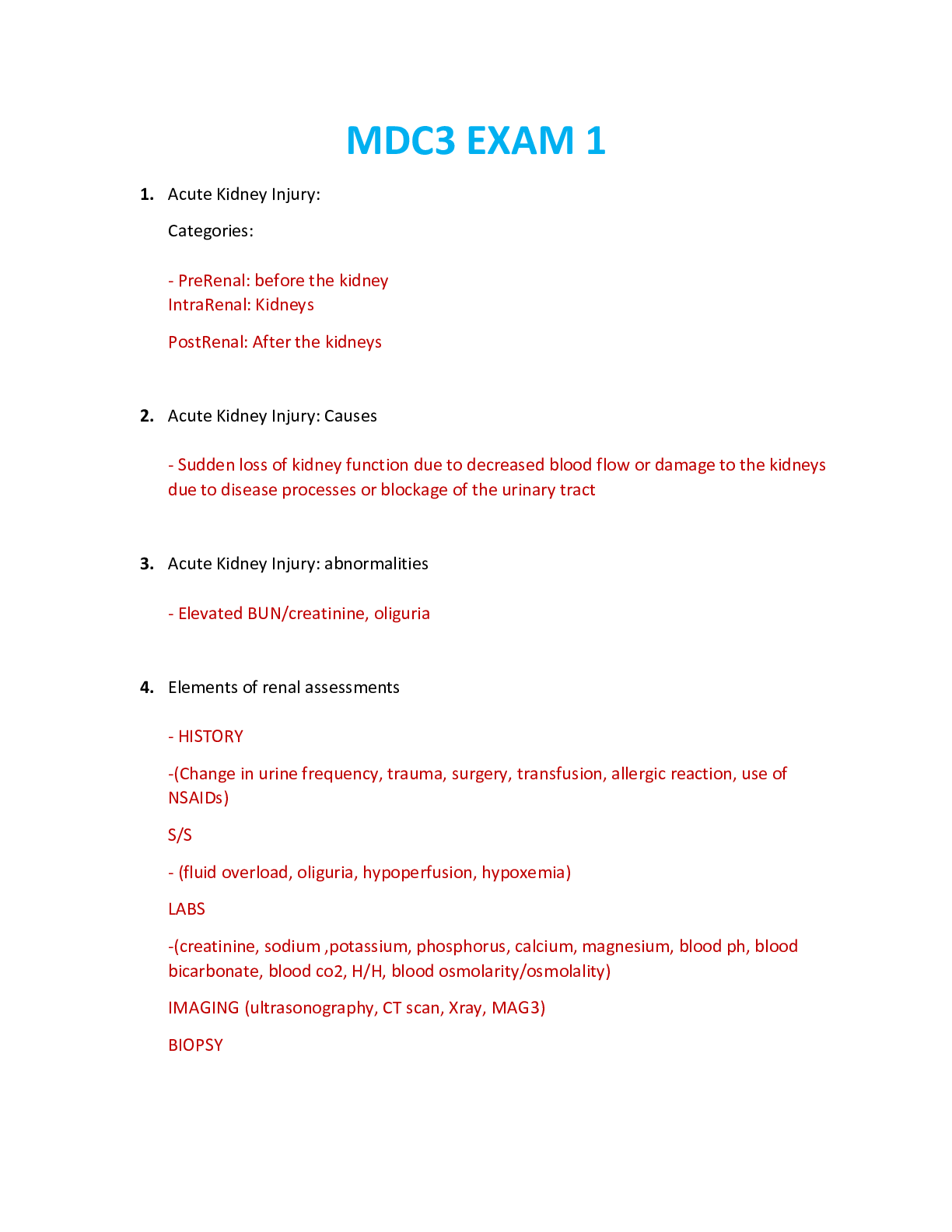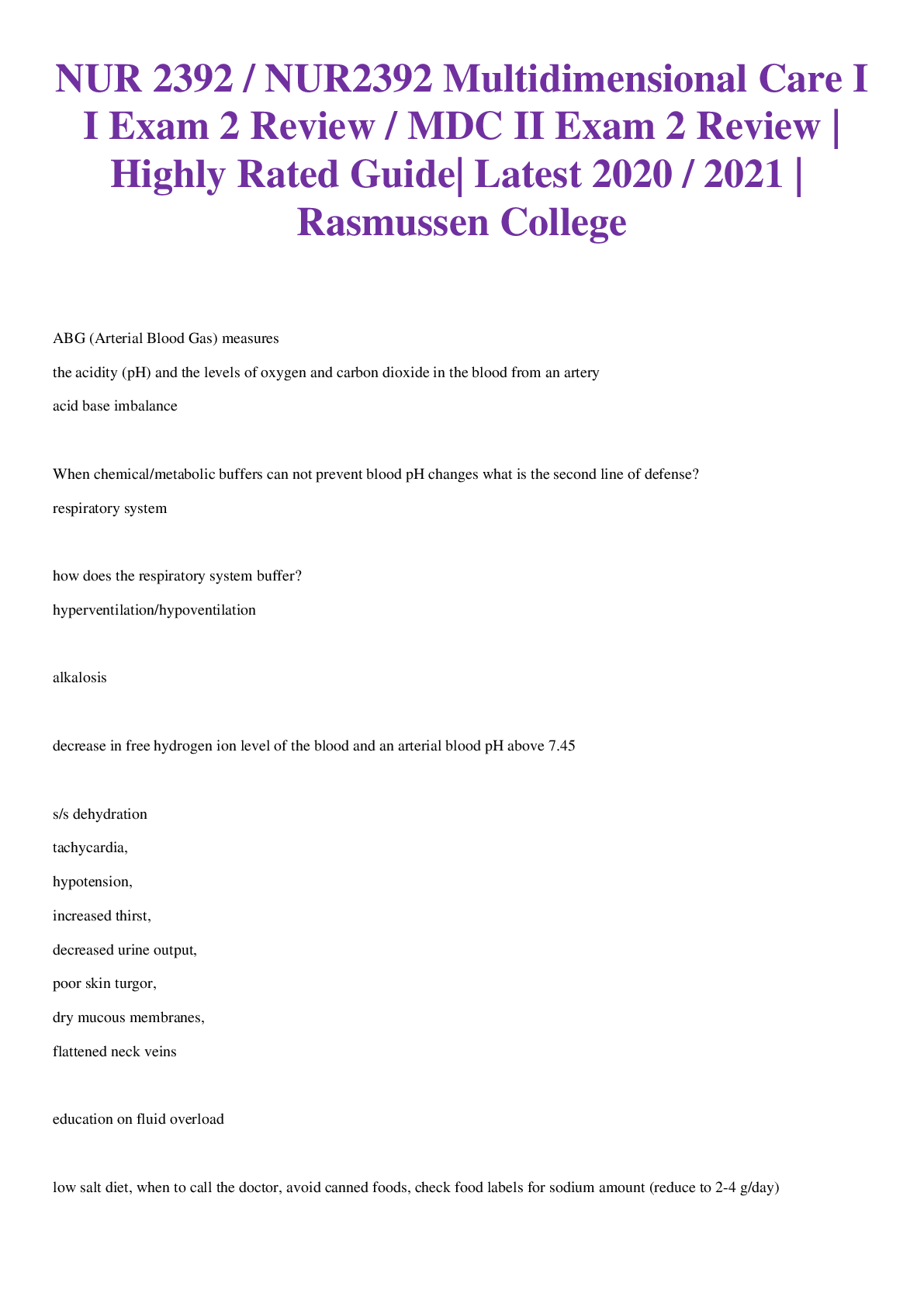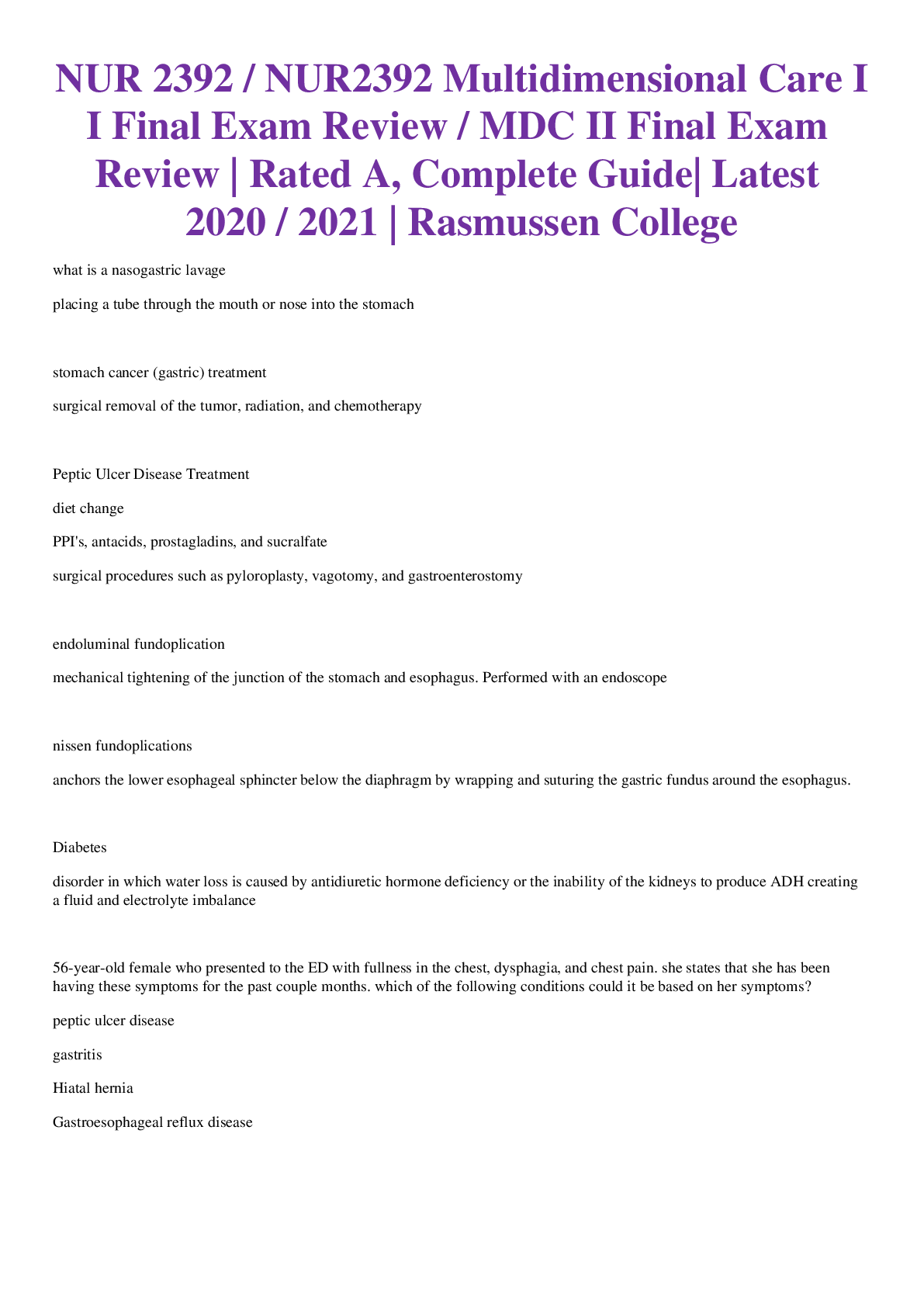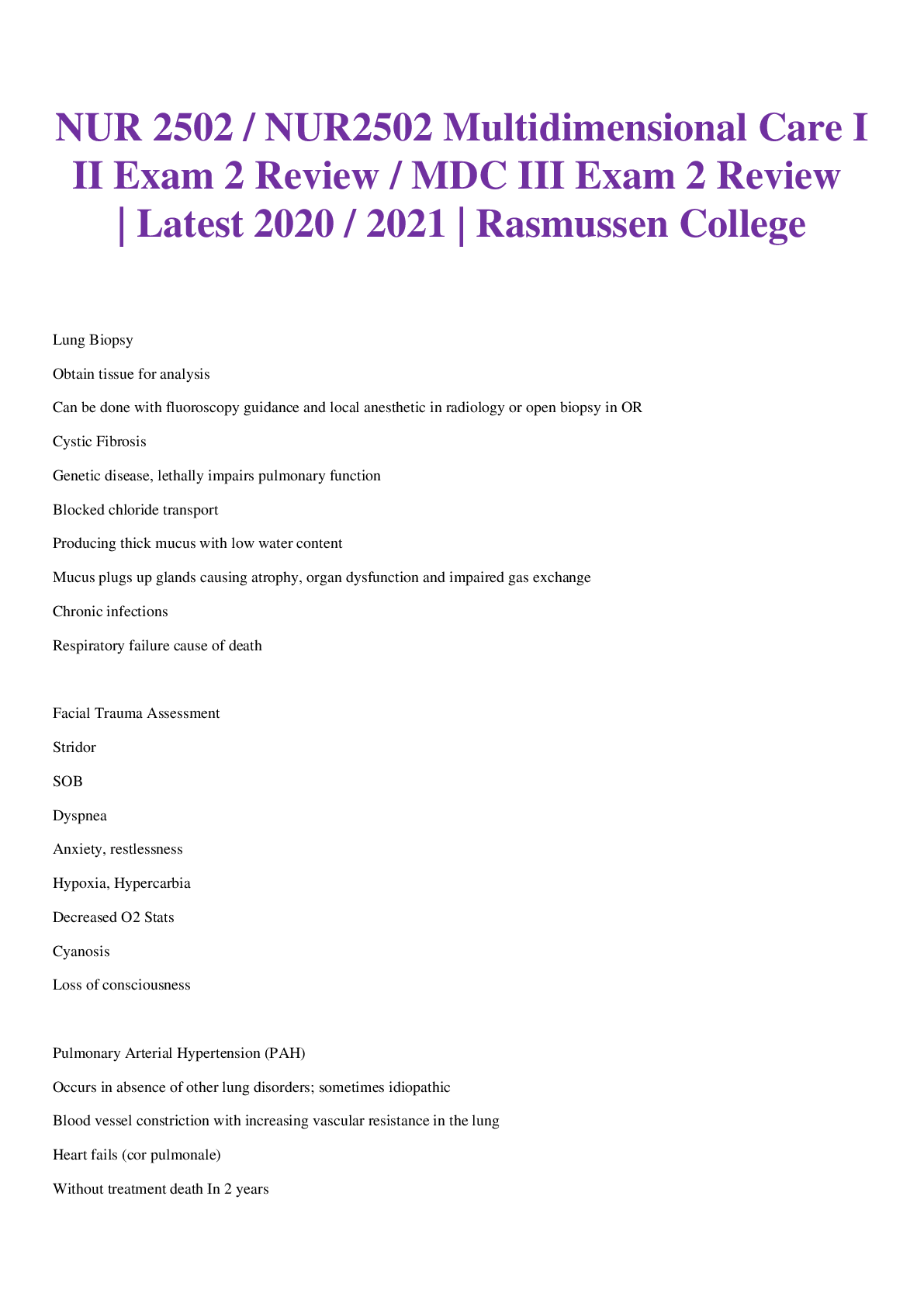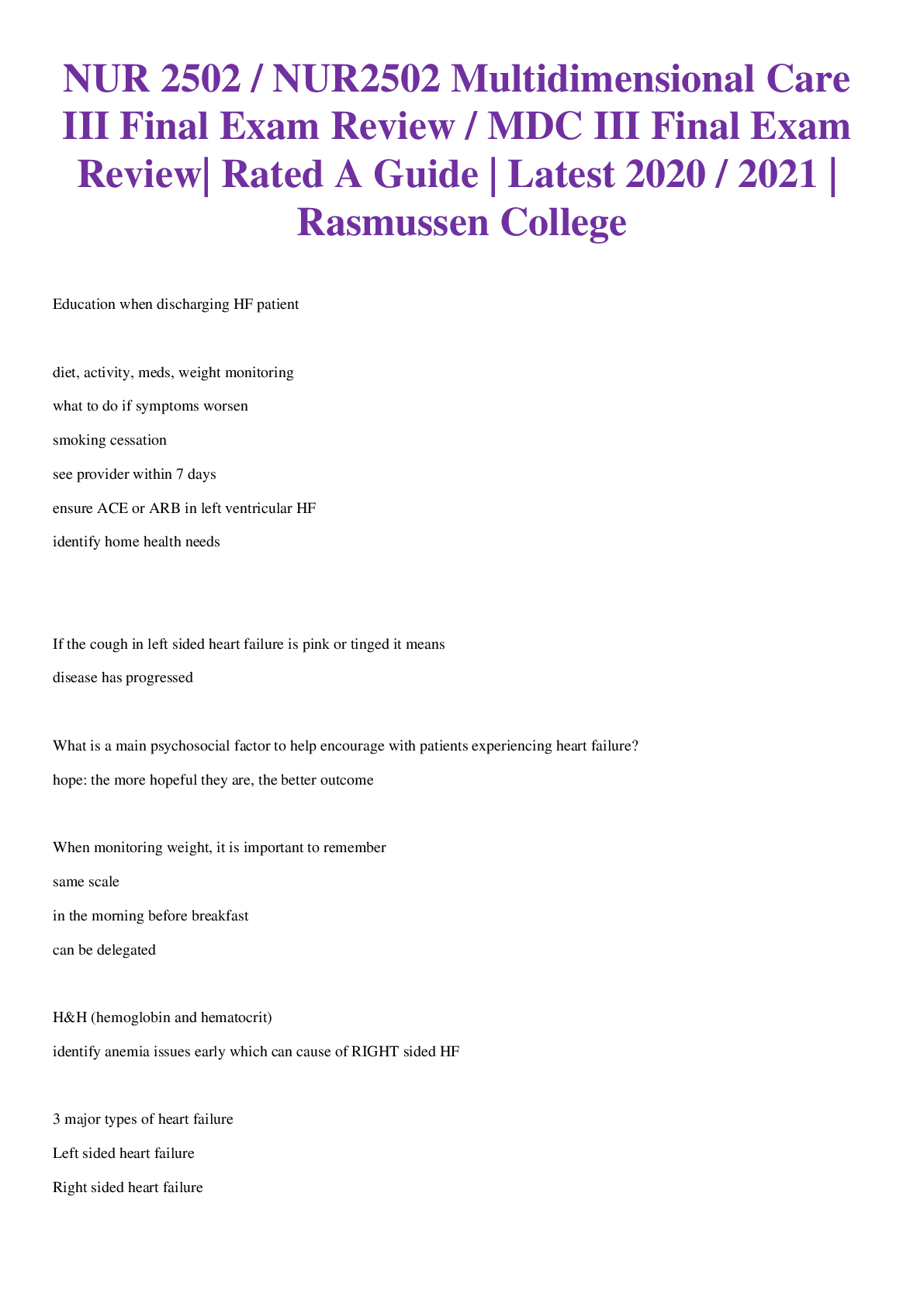Health Care > EXAM > Summary NUR 2392 / NUR2392: Multidimensional Care II / MDC 2 Exam 1 Blueprint (Latest 2021 / 2022) R (All)
Summary NUR 2392 / NUR2392: Multidimensional Care II / MDC 2 Exam 1 Blueprint (Latest 2021 / 2022) Rasmussen College
Document Content and Description Below
Pathophysiology of Death- Death is defined as the cessation of integrated tissue and organ function, manifesting with lack of heartbeat, absence of spontaneous respirations, or irreversible brain dys... function. S/S of Approaching death- As death nears, patients often have signs and symptoms of decline in physical function- manifesting as weakness increased sleep. anorexia changes in cardiovascular function breathing patterns genitourinary function. Level of consciousness often declines to lethargy, unresponsiveness, or coma. Cardiovascular dysfunction leads to decreases in peripheral circulation and poor tissue perfusion manifesting as cold, mottled, and cyanotic extremities. Blood pressure decreases and often is only palpable. The dying person’s heart rate may increase, become irregular, and gradually decrease before stopping. Changes in breathing pattern are common, with breaths becoming very shallow and rapid. Periods of apnea and Cheyne-Stokes respirations (apnea alternating with periods of rapid breathing) are also common. Death occurs when respirations and heartbeat stop. o Management of symptoms Patient and Family Education: Preparing for Self-Management Common Physical Signs and Symptoms of Approaching Death With Recommended Comfort Measures Coolness of Extremities Circulation to the extremities is decreased; the skin may become mottled or discolored. 1. • Cover the patient with a blanket. 2. • Do not use an electric blanket, hot water bottle, or electric heating pad to warm the patient. Increased Sleeping Metabolism is decreased. 1. • Spend time sitting quietly with the patient. 2. • Do not force the patient to stay awake. 3. • Talk to the patient as you normally would, even if he or she does not respond. Fluid and Food Decrease Metabolic needs have decreased. 1. • Do not force the patient to eat or drink. 2. • Offer small sips of liquids or ice chips at frequent intervals if the patient is alert and able to swallow. 3. • Use moist swabs to keep the mouth and lips moist and comfortable. 4. • Coat the lips with lip balm. Incontinence The perineal muscles relax. 1. • Keep the perineal area clean and dry. Use disposable under pads and disposable undergarments. 2. • Offer a Foley catheter for comfort. Congestion and Gurgling The person is unable to cough up secretions effectively. 1. • Position the patient on his or her side. Use toothette to gently clean mouth of secretions. 2. • Administer medications to decrease the production of secretions. Breathing Pattern Change Slowed circulation to the brain may cause the breathing pattern to become irregular, with brief periods of no breathing or shallow breathing. 1. • Elevate the patient’s head. 2. • Position the patient on his or her side. Disorientation Decreased metabolism and slowed circulation to the brain. 1. • Identify yourself whenever you communicate with the person. 2. • Reorient the patient as needed. 3. • Speak softly, clearly, and truthfully. Restlessness Decreased metabolism and slowed circulation to the brain. 1. • Play soothing music and use aromatherapy. 2. • Do not restrain the patient. 3. • Talk quietly. 4. • Keep the room dimly lit. 5. • Keep the noise level to a minimum. 6. • Consider sedation if other methods do not work. o Postmortem Care • Provide all care with respect to communicate that the person was important and valued. • Ask the family or significant others if they wish to help wash the patient or comb his or her hair; respect and follow their cultural practices for body preparation. • If no autopsy is planned, remove or cut all tubes and lines according to agency policy. • Close the patient’s eyes unless the cultural or religious practice is for a family member or other person to close the eyes. • Insert dentures if the patient wore them. • Straighten the patient and lower the bed to a flat position. • Place a pillow under the patient’s head. • Wash the patient as needed and comb and arrange the patient’s hair unless the family desires to perform bathing and body preparation. • Place waterproof pads under the patient’s hips and around the perineum to absorb any excrement. • Clean the patient’s room or unit. • Allow the family or significant others to see the patient in private and to perform any religious or cultural customs they wish (e.g., prayer). • Assess that all who need to see the patient have done so before transferring to the funeral home or morgue. • Notify the hospital chaplain or appropriate religious leader if requested by the family or significant others. • Ensure that the nurse or physician has completed and signed the death certificate. • Prepare the patient for transfer to either a morgue or a funeral home; wrap the patient in a shroud (unless the family has a special shroud to use), and attach identification tags per agency policy. Hospice vs Palliative Care Impact of Pain & Pain Management Impact of Unrelieved Pain Physiologic Impact Quality-of-Life Impact • Prolongs stress response • Increases heart rate, blood pressure, and oxygen demand • Decreases GI motility • Causes immobility • Decreases immune response • Delays healing • Poorly managed acute pain increases risk for development of chronic pain • Interferes with ADLs • Causes anxiety, depression, hopelessness, fear, anger, and sleeplessness • Impairs family, work, and social relationships Financial Impact Costs Americans billions of dollars per year Increases length of hospital stay Leads to lost income and productivity [Show More]
Last updated: 2 years ago
Preview 1 out of 49 pages

Buy this document to get the full access instantly
Instant Download Access after purchase
Buy NowInstant download
We Accept:

Reviews( 0 )
$14.00
Can't find what you want? Try our AI powered Search
Document information
Connected school, study & course
About the document
Uploaded On
Jul 28, 2022
Number of pages
49
Written in
Additional information
This document has been written for:
Uploaded
Jul 28, 2022
Downloads
0
Views
131



.png)













